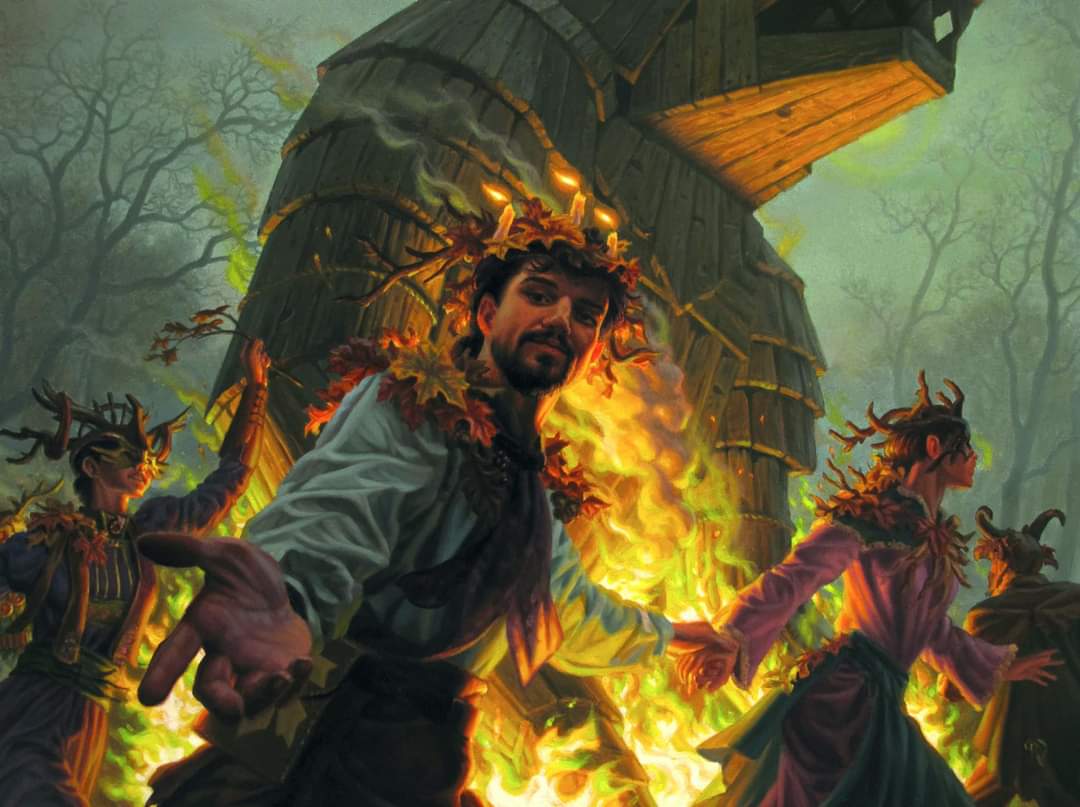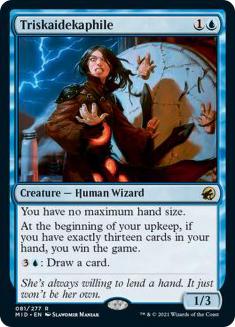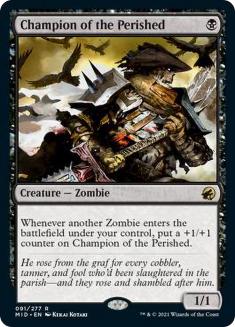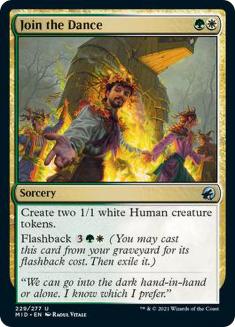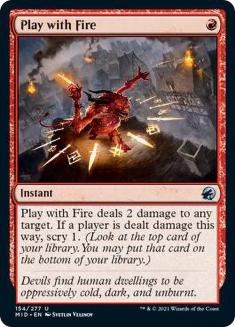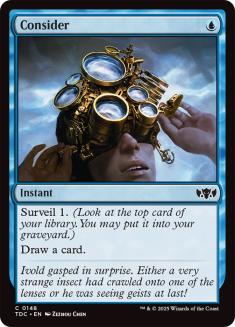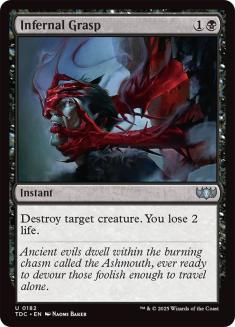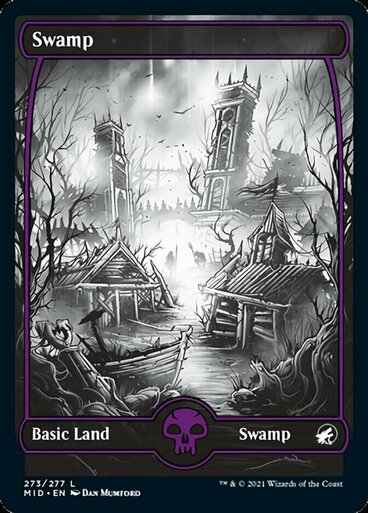New cards for Commander come at us at a breakneck pace these days and have for quite a while. The adrenaline from the last bit of excitement hasn’t yet worn off while we’re taking our first looks at the next thing to get our blood pumping. Being a fan of the game is nearly a full-time job; even those of us who are highly invested content creators can get pushed past a saturation point. It’s both thrilling and wearying. I’ll talk today about strategies for mitigating that new card fatigue — right after getting justifiably hyped about the first previews from Innistrad: Midnight Hunt. The first up is a doozy.
Previews Aplenty
The next version of Wrenn and Six (making us wonder about One through Five) continues the land theme planted by its predecessor. At five mana for five loyalty, it’s already starting ahead of the value curve. The [+1] ability gives you all the lands in the top four cards of your library; perhaps more interestingly, it mills the rest. Dredge and Reanimator strategies will enjoy the double boost.
The [0] ability is the one that’s likely to put you into overdrive and is the one most folks are stoked about. It puts any number of land cards from your hand onto the battlefield. They come in tapped, but the initial hit here is for any kind of landfall strategy anyway. Whether you’re making your Plants big with Avenger of Zendikar or bringing back a fair amount of your graveyard with Emeria Shepherd, there’s plenty of value to here. Even better, Wrenn and Seven isn’t quite done yet.
The [-3] ability offers what could be a huge beater, and in certain late-game circumstances, might be the option you go for right away. The tendency with planeswalkers is to sometime sequence their abilities top down, but you can get the creature (nominally a 5/5) first, and then use the [0] ability the following turn to make it larger now that it can attack. The dynamic power and toughness mean that in most games, your Treefolk friend will only get larger and larger.
Unusually, the ability for [-8] might be the least compelling of them all. Wrenn and Seven doesn’t provide itself protection (as Elspeth, Knight-Errant does, for instance), so you’ll need some external help to get there. With Doubling Season you can get to it straight away, but I keep focusing on the fact that if I have eight loyalty counters on Wrenn and Seven, that’s two big Treefolk on the way to a third. The ability limits what you return to permanents, so spell-based combos are out. You’ll probably build around Wrenn and Seven so that many of those permanents are lands, allowing you to drop them onto the battlefield next turn, assuming you had more than eight counters. I don’t want to be too dismissive about the [-8] ability, though. Having a full grip and no maximum hand size that you didn’t have to pay Praetor’s Counsel mana for is pretty strong.
The first commander that comes to mind for Wrenn and Seven is The Gitrog Monster. You’ll already be in some kind of lands matter strategy. With the [+1] ability you’ll be getting extra lands to drop, making your eventual Treefolk that much larger. What interests me here is that, being in black, you can play Syr Konrad, the Grim. Should you activate Wrenn and Seven’s [-8] ability, Syr Konrad will trigger on any creatures leaving your graveyard and going back into your hand, many of which he’ll have put there himself. Syr Konrad also suggests those reanimation strategies I mentioned. See also: Muldrotha, the Gravetide.
Lord Windgrace is another clear commander option for the card. Again, Wrenn and Seven’s [+1] ability gives you extra lands to use, in this case for Lord Windgrace’s [+2] ability. Then Lord Windgrace’s [-3] ability will tick up your Treefolk even more. Synergy abounds.
The card to watch out for when playing Wrenn and Seven is Confounding Conundrum. Packing enchantment removal is always a good idea, doubly so when a single enchantment can shut you down so hard.
The only downside I see to Wrenn and Seven is that while it’s not strictly linear, it does its thing in a pretty narrow band. I looked for some outside-the-box ideas and couldn’t find anything all that thought-provoking. Players are justifiably excited about the card because it’s good with lands and lands matter in Magic.
Following the theme of thirteen set out by Triskaidekaphobia in Shadows over Innistrad, and arguably Army of the Damned from OG Innistrad (and a super-stretch if you want to consider Elbrus, the Binding Blade from Dark Ascension), Triskaidekaphile is an alternate win condition card that you’ll have to be exacting about to win with. First of all, it simply grants you the bonus of no maximum hand size. It also draws a card for 3U without having to tap. At an inexpensive 1U to cast for a 1/3, those might make it worth playing, especially since it’s a Human Wizard that slots right into Azami, Lady of Scrolls.
The big part of Triskaidekaphile is the upkeep trigger that’ll win you the game if you have exactly thirteen cards in hand. What makes it tricky is that you have to have that exact number in hand both when the ability would trigger (otherwise it won’t go on the stack) and when it would resolve. For more details, check out Rule 603.4, otherwise known as the intervening if clause. The good news is that once it triggers, removing the creature won’t save your opponents. They can’t get you to burn a counterspell to protect it. At that point, only changing your hand size will help. Since there isn’t that much instant-speed discard, it’ll probably be some knucklehead with a Temple Bell that gets you. Still, having that many cards in hand is its own reward — and if you want a free discard outlet, there’s always Aquamoeba.
Punning cleverly on the Human Soldier Champion of the Parish, the Zombie (no second creature type) Champion of the Perished is much scarier. Zombies are easier to make in big batches than Humans, with cards like the aforementioned Army of the Damned and Zombie Apocalypse leading the charge. With cards like these, Champion of the Perished can go from tiny to immense in a single shot.
For more sustainable growth, give Tombstone Stairwell a whirl. On each player’s upkeep you’ll grow your Champion by one for each creature card in your graveyard. Unlike many cards of its ilk, which would have you sacrifice or exile the tokens at the beginning of each end step or when the card leaves the battlefield, Tombstone Stairwell destroys them. A well-placed Eldrazi Monument or well-timed Rootborn Defenses can be pretty swingy.
Our first multicolored flashback card, Join the Dance isn’t likely to be a big player in the format. It might have a place in some Human token builds, but it’s more of a Limited star than a Commander card.
Strict Upgrades: Play with Fire, Consider, and Infernal Grasp
The differences are small and hardly game-breaking, but two Innistrad: Midnight Hunt cards look like they’ll be putting two classics out of business. Play with Fire is an improved Shock, stapling a conditional scry onto the spell. However, Consider is the one that’s likely to see more Commander play, pushing aside Opt as a deck-thinning and cantrip choice. The difference with Consider is that you have the choice of putting the card into the graveyard as opposed to shipping it to the bottom of your library. It might not seem all that big of a deal, but the simple action opens a new host of opportunities, moving you into graveyard strategies.
The waters might be a little murkier considering Infernal Grasp an improvement to Doom Blade, since there’s life loss involved, but I’m going to call it good. To be fair, two life is only a big deal in Commander if it’s your last two. What you get for that life payment is the ability to target black creatures. Maybe it’s a little closer to Swift End, the Adventure part of Murderous Rider; for one less mana, you can’t target a planeswalker.
Some folks will lament the fact that old favorites are rendered obsolete by newcomers. To some extent, it’s inevitable in the extremely long lifespan of Magic. If it’s going to happen, I’d rather it be in small doses like these cards demonstrate. Are they slightly better? Sure. Are they game- or format-changers? Not in the least, and certainly not in the way that creatures have been pushed in recent years.
Those Lands
The full-art basic lands included in the set drip with theme and flavor. From an artistic sense, I’m a fan of black-is-now-purple. I suspect that I won’t be the only person to rush out and find a bunch of “ruins of Innistrad” version of the Swamp to put a deck together with. I’ll have to see the other four colors of lands live before I’m ready to make a judgment on them. From looking online, there might not be enough difference to easily tell them apart from across the table but I’m willing to concede that the colors might pop and make it a non-issue (save for our friends who struggle distinguishing colors).
New Card Fatigue: The Struggle Is Real
You probably don’t need much help, but it’s part of my job to enhance your excitement about new Magic cards coming out. So what happens when I experience the same feeling that many of you do, namely getting overwhelmed by the sheer pace of releases? First, I think it’s important to be honest about feeling it. It’s not a moral failing to want to be able to catch a breath and just enjoy what you just got your hands on. Second, we have to develop strategies to help us deal with what we’re feeling so that we make sure that the game of Magic is a joy and not a chore. Here are some of the things I do.
Reconcile FOMO
This is the big one. In order to make Magic a game in which there’s something for everyone, it’s nearly impossible for everything to be for someone. There was a time when I was going to collect one of every Magic card, save obviously the unique ones like Splendid Genesis. Now, there’s simply no way to do it all. It’s not even a question of resources, but of time. With foil versions, regular versions, alternate art versions, Secret Lairs, and more, merely the administrative overhead to manage a collection in that fashion is just too much. I really had to let it go.
It’s more than that, though. I had to let go of knowing everything. There are so many new cards in any given year that unless you’re playing multiple formats full time (probably three — Standard, Limited and Commander), you’re not going to know the names and functions of all the news stuff that gets printed. When I was a Level 5 Judge, sure. Now, I have to let myself off the hook and be comfortable with “What’s that one do again?”
Step Away — With a Return Plan
This one’s especially important for content creators. Sometimes, you just have to put it all down. I think that there’s this fear that if you miss one set release, one stream, one event of any kind, you’ll run the risk of losing followers and becoming less relevant. We want our fan base to be an ever-increasing rocket ship upward when the truth is things are more dynamic. Your brand is good; if your numbers dip on one thing, they’ll jump back up on another. When the stress is greater than the reward, just step away.
Even for those who aren’t in the content game, it’s okay to be a little behind on what the latest and greatest is. The good news is that the cards will still be here when you get back — and so will all the great content that folks like us at Star City Games have produced. Set reviews and new tech ideas might have a limited shelf life, but it’s not so limited as to be irrelevant even after a few weeks. Nothing in Commander is so pressing and immediate that you need to sacrifice your enjoyment over it.
For those of us who are highly invested, it’s a good idea to have a plan on when to come back and digest the new things. Whether that’s just a firm date, like “Monday,” or “the first of the month,” or when you’ve met some other condition you’ve set for yourself, having an idea of when or how you’ll pick things up again will keep you from having the sense that you’re just adrift. Just last week, I decided that for Friday and Saturday I was going to put Commander stuff on the shelf for a few days. I spent the time playing other games and hanging out with friends, knowing that by Sunday I’d be chomping at the bit to get back to dealing with and writing about Commander. Worked like a charm.
Rekindle Old Loves
When I feel the pressure of new things, it helps to remember familiar ones. In a Commander context, it might simply mean playing several games with Kresh, the Bloodbraided or Karador, Ghost Chieftain instead of Breena, the Demagogue or Hofri Ghostforge. It might mean looking through that pile of cards that I’ve taken out of decks but haven’t yet found the time to properly put back where they belong to see if there’s an old friend I could repurpose. It could even be checking out a stream I haven’t visited in a while. Just because there’s a bunch of new stuff waiting out there doesn’t mean you can’t go back to what made you fall in love with the game or format in the first place.
We’re far enough removed from my time in Studio X that Innistrad: Midnight Hunt is the first set that I really don’t know that much about from a design perspective. While I’m still on the learning curve of Adventures in the Forgotten Realms, the amount that I don’t know about the new set has heightened my anticipation of it that much more. It makes me the good kind of tired.
Visit my Decklist Database to see my Signature Decks, the Chromatic Project, and more!

